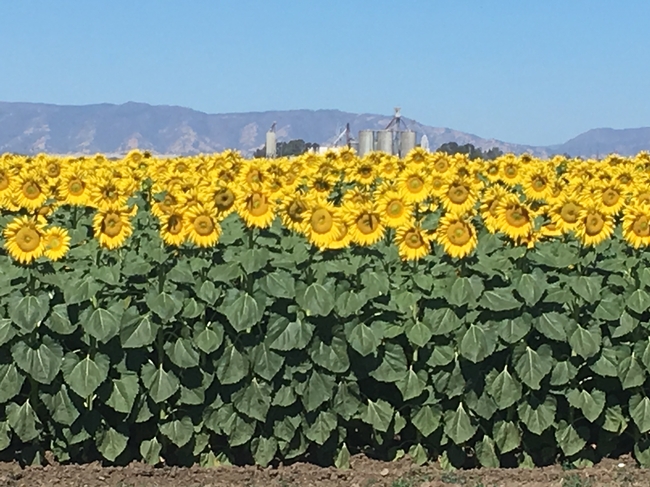UC Gardening Blogs
Ever Seen a Mantidfly?
Ever seen a mantidfly, also called a mantisfly? Bohart Museum of Entomology associate John De...
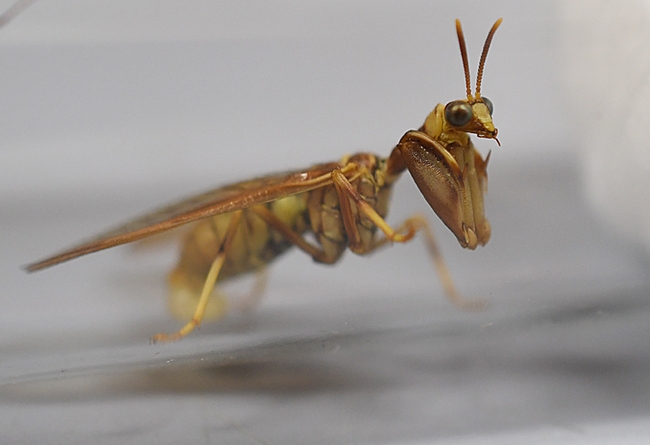
Mantidflies use their front legs to catch small insect prey. This one was collected by John De Benedictis at the UC Davis Stebbens Cold Canyon Reserve. (Snapshot by Kathy Keatley Garvey)
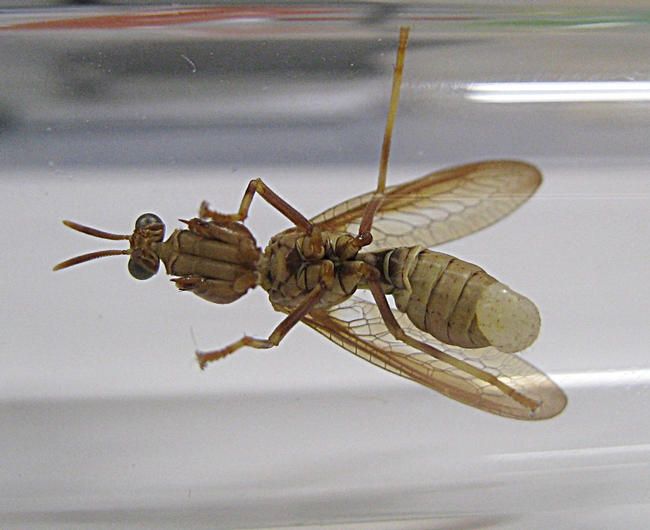
In coloring, the mantidfly abdomen resembles a paper wasp. (Photo by Kathy Keatley Garvey)
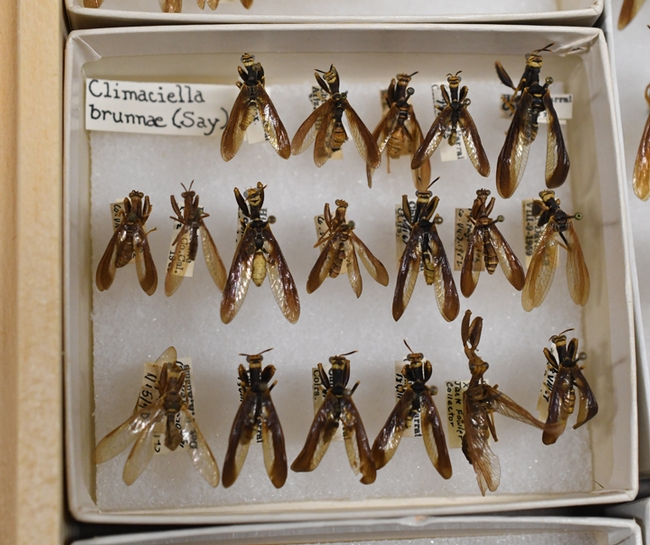
Part of the collection of mantidflies, Climaciella brunnea, at the Bohart Museum of Entomology. (Photo by Kathy Keatley Garvey)
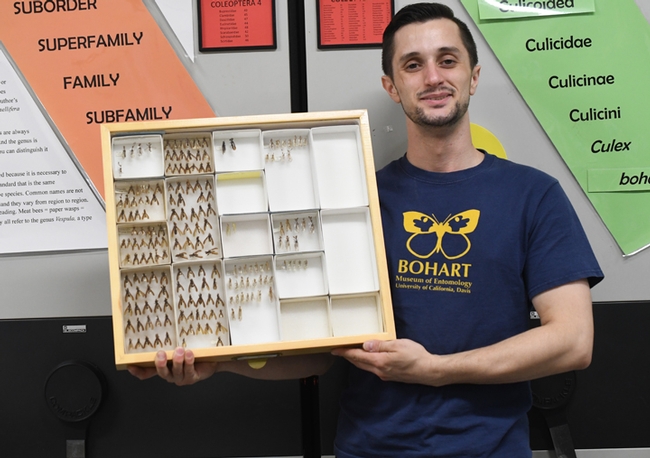
Bohart Museum of Entomology associate Wade Spencer holds a drawer of mantidfly specimens. The museum houses some eight million specimens, collected globally. (Photo by Kathy Keatley Garvey)
Sunflowers
A few evenings back, driving into town, I saw a young woman park her minivan next to a field of sunflowers. She and a little girl got out of their car and walked up to the flowers. The little girl was about the same height as the shorter stalked variety, while the woman was towered over by the taller type. I have passed the fields of sunflowers each summer in our area for many years. I have always enjoyed looking at the tournesols, as the French call them, translated “turns towards the sun”. While some think of Provence when seeing sunflowers, they actually originated in North America. Of approximately 70 varieties only 3 originated in South America.
Sunflowers were first cultivated by Native Americans. The seeds were pounded into flour for bread or cracked and eaten raw or crushed for oil. Other parts of the plant were used for body ointment, dyes, medicine, building material and ceremonial use. The Spanish explorers took the seed to Europe in the 1500's, and it has flourished there since. In the early 1700s, an Englishman devised a way to squeeze the oil from the seed on a larger scale basis. Russia became the largest grower in the 1800s. Today Ukraine is Number 1 and Russia Number 2 as the top growers in the world. The US has about 3 million acres planted with sunflowers and about 90% is of the type used for making sunflower oil. The seed pulp that is left after crushing and squeezing for the oil is used for livestock feed. Whole seeds are used for human snack food and for birdseed.
Something you may not know about sunflowers is that they were planted at Chernobyl and Fukushima after the radiation accidents at each place. A researcher from the University of Virginia, Catie Kitrinos has found that some (not all) sunflower varieties can remove toxins (lead, zinc, uranium) from the soil while growing, a process called phytoremediation. The plants are safely destroyed (not eaten) after they have matured. This process is much less costly in taking care of radioactive or heavy metal-laden soil.
Sunflowers grow quickly reaching their full height in about 120 days. Their roots can be 9 feet deep. In the fall, after they have dried on the stalk, the sunflower heads are harvested. The larger black seeds are typically used for oil, the striped ones for human snack food, and the smaller black seeds for birdseed. Birds don't actually care if seeds are striped or black and will eat what they find. Since each sunflower head can produce up to 1000 seeds, there should be plenty to share.
A B-Day Celebration for Robbin Thorp at the Bohart Museum of Entomology
It was "b-day" today at The Bohart Museum of Entomology in honor of longtime Bohart associate...
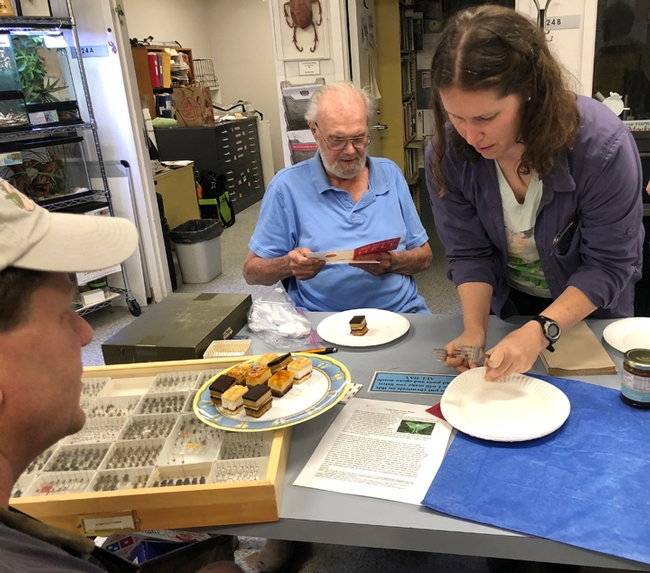
Tabatha Yang, education and outreach coordinator for the Bohart Museum of Entomology, serves dessert at Robbin Thorp's birthday celebration while the distinguished emeritus professor reads the birthday wishes. (Photo by Kathy Keatley Garvey)
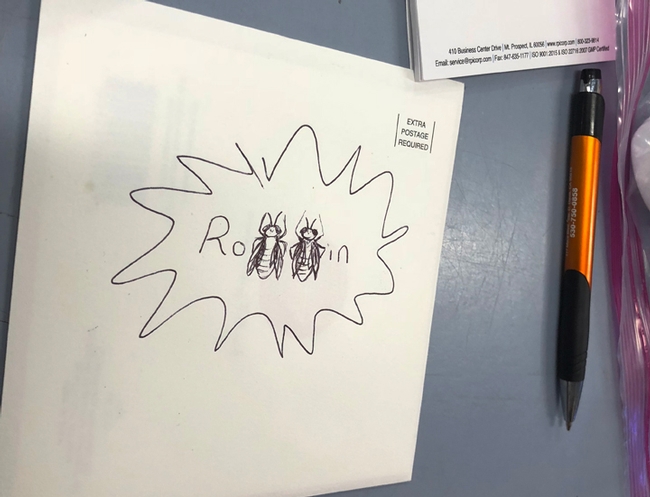
UC Davis doctoral student Charlotte Herbert Alberts created the longhorned bees on Robbin Thorp's card--putting bees in the "double b's of his name. (Photo by Kathy Keatley Garvey)
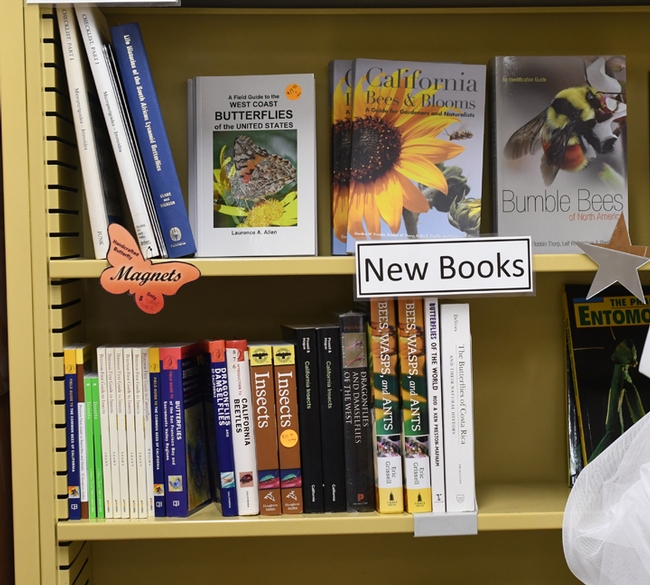
Robbin Thorp is the co-author of two books that line the gift shop of the Bohart Museum of Entomology: Bumble Bees of California: An Identification Guide (2014, Princeton University Press) and California Bees and Blooms: A Guide for Gardeners and Naturalists (2014, Heyday Books). (Photo by Kathy Keatley Garvey)
The Tree Dilemma
There is little doubt that trees are wonderful – both out in nature and in home gardens. My wife and I have lived in our current home for over 20 years and when we moved into our very modest-sized front and backyard were quite undeveloped. With the advice and consent of a Master Gardener, who was incidentally quite wonderful, I embarked on a 7-year plan since I thought that was how long we would be in the house. At this point, I have no idea where I thought we were going after 7 years. I also had my own planting ideas. So off I went and within 6 months I had put in about 20 trees. Little ones, like dwarf lemon, apricot, and peach (which is not all that small). I also put in a jacaranda, a wonderful palm (Washingtonia), an empress tree (Paulownia tomentosa), a silk tree (Albizia), 2 Arbutus, and a Robinia, and others. They all began to grow and for the (most part) stayed quite healthy.
Our house is in a hilly section of Benicia and we love our view. In fact, it is in a development that takes advantage of the view and we have a really dramatic hill-view of the Carquinez Straits and bridge which is a great source of pleasure. There is really a lot of life on urban waterways. The problem is, our neighbors also treasure their view.
The smaller trees grew quite well and before too long we were able to give bags of fruit to the neighbors and to receive their largesse also. All good. The big trees, however, also grew rather spectacularly. I must say I feel like I did nothing to encourage them other than look at them often with admiration. They were placed so that they didn't interfere with our view, but not so for the neighbors, who seemed to enjoy the arboreal majesty as much as we did. Much to their credit, there were no big complaints. In fact, we weren't noticing just how intrusive they were for the neighbors until we were standing on their property and happened to notice that they couldn't see the water anymore. Clearly, our seven-year plan had some limits: we had outgrown it.
It was a hard decision, but we thought it best for neighbor goodwill to cut some down. So, after 15 years of enjoying them, many had to come down. I tried to be as selective as I could about what to eliminate, but I missed each and every one. It is amazing to me just how much majesty the big trees added to the garden space and the property as a whole.
I ask myself what I learned from the experience. I got 15 years of enjoyment from the trees and that makes it worth doing, keeping in mind what the neighborhood can bear. Gardening is a community event, in a private garden as well as a public one. And a good neighbor policy has to be part of the landscaping plan.
Monarch Madness: Thanks, Monarch Mama!
Thar's gold in them thar hills? Probably not. But thar's definitely gold in that there pollinator...
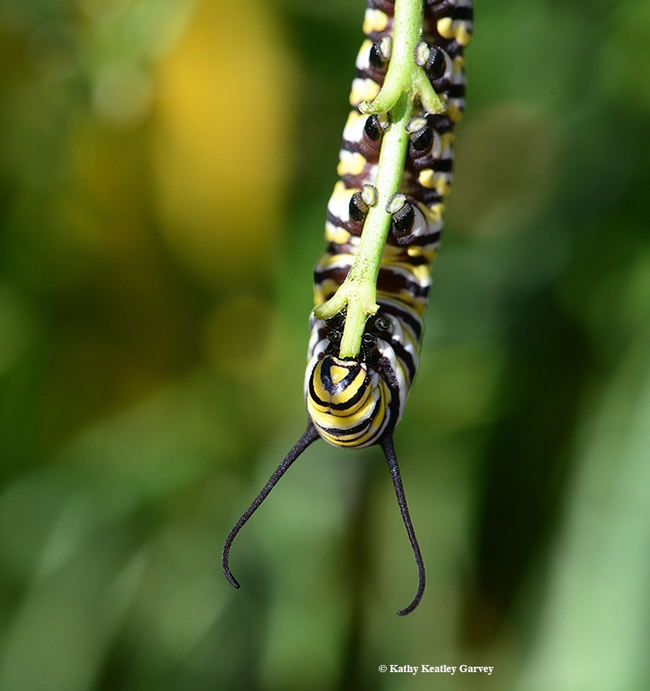
A hungry monarch caterpillar chewing on a milkweed stem this morning in a Vacaville pollinator garden. (Photo by Kathy Keatley Garvey)
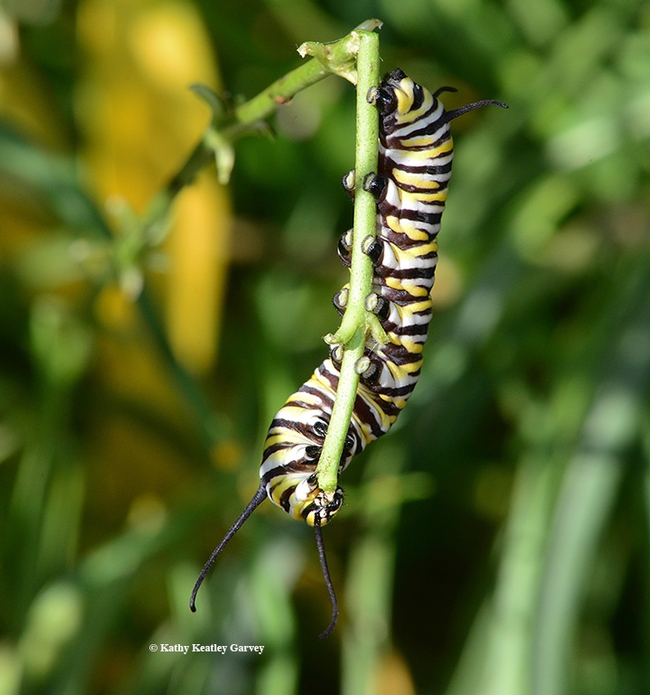
The monarch caterpillar swirls to get the best angle. (Photo by Kathy Keatley Garvey)
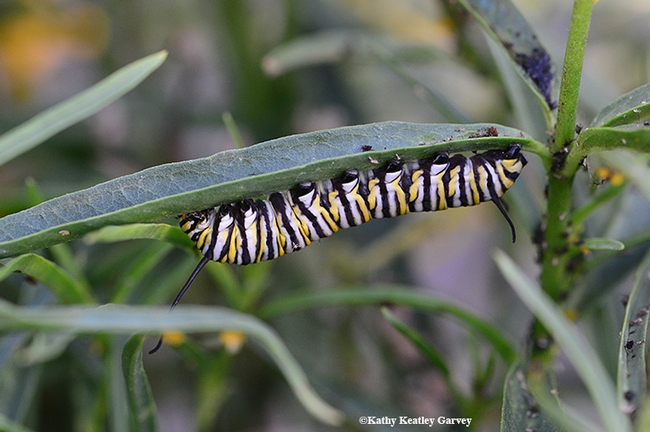
The long and short of it--a monarch caterpillar crawls on a stem to its next dining spot. (Photo by Kathy Keatley Garvey)
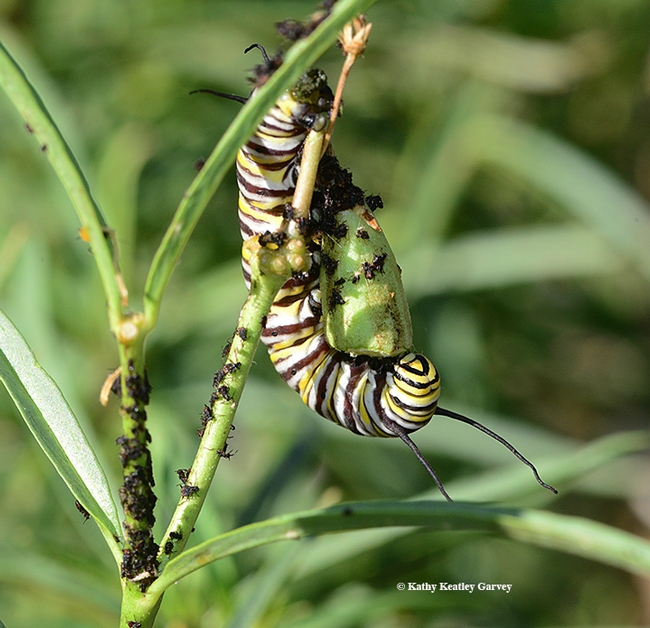
Even seed pods are fair game for hungry monarch caterpillars. (Photo by Kathy Keatley Garvey)
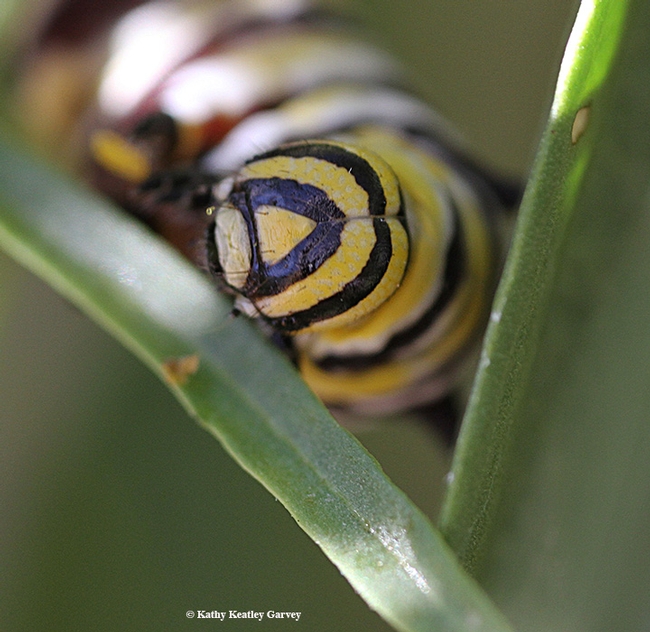
Close-up of a monarch caterpillar, taken with a Canon MPE-65mm lens. (Photo by Kathy Keatley Garvey)




